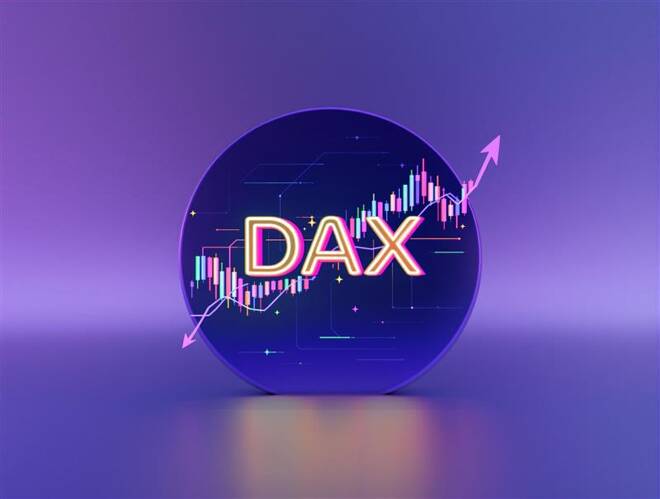Advertisement
Advertisement
Dax Index News: Trade Deal Buzz and Fed Cut Bets Lift DAX – Market Forecast Today
By:
Key Points:
- DAX rises 0.90% to 24,227 as US-EU natural gas deal revives hopes for a broader transatlantic trade agreement.
- A 30% US tariff on EU goods looms, making the success of trade talks critical to avoid escalation risks.
- DAX outlook hinges on US retail sales, jobless claims, and potential progress on US-EU trade deal talks.
DAX Opens Higher as Natural Gas Deal Boosts Trade Deal Hopes
A deal between US and EU firms to buy US natural gas fueled speculation about a US-EU trade deal. The DAX rallied 0.90% to 24,227 in early trading on Thursday, July 17, attempting to snap a five-day losing streak.
Reports that Italy’s ENI and US-based gas producer Venture Global agreed to a deal to ship 2 million metric tons of liquefied natural gas per year over 20 years raised hopes for a broader US-EU trade agreement. President Trump has pressured the EU to reduce the trade deficit by acquiring US oil and gas or face punitive tariffs.
The US could impose a 30% tariff on EU goods, effective August 1, if trade talks fail. Daniel Kral, a European macro specialist, underscored the importance of a trade deal, stating:
“A 30% US blanket tariff on EU imports from August would be prohibitive, risking a US-China style escalatory dynamic. China’s surplus with the EU is trending toward $400bln this year (up from 330bln in ’24) based on Eurostat (exports up, imports down again). EU squeezed from both sides.”
Sector Performance: Autos and Tech Stocks Shine
Optimism about a potential US-EU trade deal boosted export-linked auto and tech stocks. Infineon Technologies and SAP climbed 1.99% and 1.35%, respectively.
Mercedes-Benz Group led the auto sector,, gaining 1.61%, while Volkswagen rose 1.20%. BMW and Porsche also posted strong early gains.
Wall Street Climbs on Fed Rate Cut Bets
US markets closed higher on Wednesday, July 16, as investors reacted to softer US producer prices. The Dow gained 0.53%, while the Nasdaq Composite Index and the S&P 500 rose 0.25% and 0.32%, respectively.
US producer prices increased 2.3% year-on-year in June after rising 2.7% in May. Economists consider producer prices a leading inflation indicator. The softer numbers raised expectations of a September Fed rate cut, boosting demand for US-listed stocks.
According to the CME FedWatch Tool, the probability of a September Fed move rose to 59.6% on July 16, up from 55.6% on July 15.
US Retail Sales and Jobless Claims to Fuel Risk Sentiment
Later in the Thursday session, US retail sales and labor market data will influence the Fed rate path. Economists forecast retail sales to rise 0.1% month-on-month in June after sliding 0.9% in May.
A modest pick-up in consumer spending may further ease US recession fears, supporting demand for risk assets such as the DAX. Conversely, another drop in retail sales may retrigger recession fears, given that private consumption accounts for over 60% of US GDP.
Economists expect initial jobless claims to rise from 227k (week ending July 5) to 235k (week ending July 12). A modest rise may support Fed rate cut expectations. On the other hand, a sharp fall in claims could support a more hawkish Fed policy stance, potentially weighing on the DAX.
While Thursday’s US data will influence risk sentiment, trade developments remain the key driver for the DAX.
Near-Term Outlook
The DAX’s near-term outlook depends on US-EU trade developments, US economic data, and central bank policy guidance.
- Bearish Scenario: Stalled US-EU trade talks or strong US data fueling hawkish central bank cues. Under these scenarios, the DAX may drop below 24,000, bringing the 50-day EMA into play.
- Bullish Scenario: A US-EU trade deal, softer US data, and dovish central bank rhetoric may drive the DAX toward the July record high of 24,639.
DAX Technical Indicators
Daily Chart
Despite recent losses, the DAX remains above the 50-day and 200-day Exponential Moving Averages (EMA). The EMAs signal a continuation of the broader bullish trend.
A breakout above the July 15 high of 24,267 could pave the way to the record high of 24,639. Sustained buying pressure may drive a move toward the 24,750 level.
On the downside, a break below 24,000 could expose the 23,750 level. Increased selling pressure may enable the bears to target the 50-day EMA.
The 14-day Relative Strength Index (RSI), at 56.43, indicates the DAX could climb to 24,639 before entering overbought territory (RSI > 70).
Final Thoughts
Overall, the DAX remains at a technical crossroads, with geopolitical and macroeconomic developments likely to dictate the next directional move.
Traders should monitor both technical and fundamental drivers and consult our economic calendar.
About the Author
Bob Masonauthor
With over 28 years of experience in the financial industry, Bob has worked with various global rating agencies and multinational banks. Currently he is covering currencies, commodities, alternative asset classes and global equities, focusing mostly on European and Asian markets.
Advertisement
